There is a few types of Galant VR4 :
Credits to Ryan Heart'z from galantvr4.org
Please do not hotlink this picture / steal my server's bandwidth , find your own provider if you want to link it some where .
20 Images of models & specs , non user friendly for 56k connection .
This car / engine is well known in the malaysian motoring scene , lots of critics from other car make's , stated by those rival's : this engine is old very troublesome , hard to maintain and etc etc . well to tell you the truth im a proud user of the vr4 even its an old junk , its been proven and had won the rally championship back in those day's , so have your say !




1st Gen VR4 1987 - 1989



Galant VR4 RS 1989



Galant Super VR4



Galant AMG




Galant Monte Carlo
This model came out after wining the rally in monte carlo



More Facts on the Galant Vr4












Stage 1 mods estimated 300hp :
Step 1
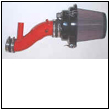
Intake Pipe and Filter
A performance intake filter will help throttle response and help all future mods achieve maximum performance. A hard intake pipe will also improve air flow over the factory piece.
Step 2
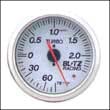
Aftermarket Boost Gauge
The stock boost gauge is simply not accurate. To avoid severe engine damage when increasing boost levels, an aftermarket unit is mandatory.
Step 3
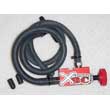
Boost Controller
In order to raise boost levels, you'll need a boost controller. Whether it be a manual or electronic unit will depend on your budget.
Step 4
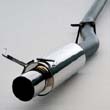
Cat-back Exhaust System
A 2.5" or 3", high flow exhaust system is needed to gain more power. The factory exhuast is very restrictive and hurts power
Step 5
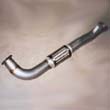
High Flow Downpipe
The factory downpipe is very restrictive and should be replaced with a larger, better flowing unit. For Stage 1, a 2.5" downpipe will do. If future plans involve 500+ horsepower, consider a 3" downpipe.
Step 6
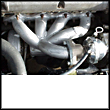
Exhaust Manifold
The exhaust manifold on 1G DSMs are notorious for cracking and leaking. The solution is to replace it with a ported factory 95-99 exhaust manifold. If you're planning on going with a full Garrett turbo, you'll need a special manifold.
Step 7
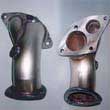
O2 Sensor Housing
The downpipe bolts up to a 90 degree elbow called the O2 Sensor Housing. This is the last restriction in the exhaust system. The stock unit can be ported out, or you can simply buy a better flowing unit.
Step 8
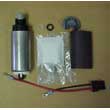
Fuel Pump
The stock fuel pump will not be able to supply the needed fuel for long - especially if the boost level is raised. A high flow unit will be needed. It's also a good idea to re-wire the fuel pump for consistent fuel pressure
Step 9
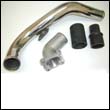
Intercooler Piping
The rubber intercooler piping should be replaced with better flowing solid pipes. Some replacements will come with a larger throttle body elbow (which is needed also). The turbo outlet elbow should be swapped out for a larger unit as well. Please note that if a Stage 2 setup is in the plans, this upgrade may not be necessary as the intercooler piping will likely be routed differently.
Step 10
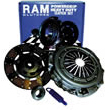
Performance Clutch
With more power on tap, the stock clutch probably won't last that long. It will start to slip, especially in the higher gears. This means it's time for a high performance clutch.
Please Note: 1G automatic transmission cars have a smaller stock turbo (the Mitsubishi 13G) than the 5-speed cars and will require a turbo upgrade in order to achieve Stage 1 performance levels.
Stage 2 estimated 400hp :
Step 1

Logging Software
Before you can safely begin making fuel adjustments, you'll need to know what's going on inside the engine. Logging software will give you this data and will help you decide what fuel delivery changes are needed, how much change is needed, and at what RPM point. Though datalogging is mainly for tuning, it's also a critical tool to prevent major engine damage as well.
Step 2

Warning Meters
Along with a datalogging solution, you'll want some gauges to help monitor the engine. While dataloggers allow you to analyze data after doing some test runs, guages are easier to read while driving. An EGT (exhaust gas temperature) gauge and probe will allow you to monitor the exhaust temperature exiting the engine. Extremely high temps generally translate into a lean condition and can be catastrophic. You can also go with a Wideband O2 system that will allow you to monitor the air/fuel ration of your car while driving. This will tell you exactly how rich or how lean the car is running, allowing you to adjust the fuel curve
Step 3

Fuel Controller/Engine Management
In order to control the flow of fuel of the larger injectors, you'll need some form of a fuel management system. This can be achieved by a piggy-back style computer which still uses the factory MAS, or using a stand alone fuel system which replaces the MAS. This will be the key component in your system. If you choose the piggy-back route, we also suggest that you look into upgrading to an EPROM ECU if your car isn't equipped with one. This allows you to get an aftermarket EPROM chip that can be programmed to work with the fuel modifications you have done.
Step 4
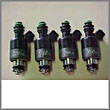
Fuel Injector Upgrade
To supply the amount of fuel necessary for Stage 2, the stock fuel injectors will need to be replaced with higher flowing units. The larger the turbo you plan on upgrading to, the larger the injectors you'll likely need.
Step 5

Turbo Upgrade
At this point, the stock 14b turbo is running at it's max. In order to increase boost, a larger turbo is necessary. You'll need something larger than a 16G or 18G in order to achieve power levels above the 375hp mark. A Mitsubishi 20G, a Mitsu-Garrett hybrid, or a full Garrett setup will be needed for higher horsepower levels. Keep in mind however, that any non-Mitsu turbo will require a special exhaust manifold, external wastegate and O2 sensor housing.
Once you've completed these mods, and only then will you have enough knowledge of how these cars handle power to go further. You should now know how tricky the art of tuning can be, and you're likely well versed in spending money on parts and repairs. It is possible to get over 600 horsepower out of the 4G63 engine, but it will require some digging into the motor to add some high performance internals. Be prepared to spend some big money.
Try to keep in mind that many repairs will need to be made when you start making these power levels due to the simple fact that things tend to break. Plan for it, especially if your car has high mileage.
Info Taken From DSM Tuners
Credits to Ryan Heart'z from galantvr4.org
Please do not hotlink this picture / steal my server's bandwidth , find your own provider if you want to link it some where .
20 Images of models & specs , non user friendly for 56k connection .
This car / engine is well known in the malaysian motoring scene , lots of critics from other car make's , stated by those rival's : this engine is old very troublesome , hard to maintain and etc etc . well to tell you the truth im a proud user of the vr4 even its an old junk , its been proven and had won the rally championship back in those day's , so have your say !




1st Gen VR4 1987 - 1989



Galant VR4 RS 1989



Galant Super VR4



Galant AMG




Galant Monte Carlo
This model came out after wining the rally in monte carlo



More Facts on the Galant Vr4












Stage 1 mods estimated 300hp :
Step 1

Intake Pipe and Filter
A performance intake filter will help throttle response and help all future mods achieve maximum performance. A hard intake pipe will also improve air flow over the factory piece.
Step 2

Aftermarket Boost Gauge
The stock boost gauge is simply not accurate. To avoid severe engine damage when increasing boost levels, an aftermarket unit is mandatory.
Step 3

Boost Controller
In order to raise boost levels, you'll need a boost controller. Whether it be a manual or electronic unit will depend on your budget.
Step 4

Cat-back Exhaust System
A 2.5" or 3", high flow exhaust system is needed to gain more power. The factory exhuast is very restrictive and hurts power
Step 5

High Flow Downpipe
The factory downpipe is very restrictive and should be replaced with a larger, better flowing unit. For Stage 1, a 2.5" downpipe will do. If future plans involve 500+ horsepower, consider a 3" downpipe.
Step 6

Exhaust Manifold
The exhaust manifold on 1G DSMs are notorious for cracking and leaking. The solution is to replace it with a ported factory 95-99 exhaust manifold. If you're planning on going with a full Garrett turbo, you'll need a special manifold.
Step 7

O2 Sensor Housing
The downpipe bolts up to a 90 degree elbow called the O2 Sensor Housing. This is the last restriction in the exhaust system. The stock unit can be ported out, or you can simply buy a better flowing unit.
Step 8

Fuel Pump
The stock fuel pump will not be able to supply the needed fuel for long - especially if the boost level is raised. A high flow unit will be needed. It's also a good idea to re-wire the fuel pump for consistent fuel pressure
Step 9

Intercooler Piping
The rubber intercooler piping should be replaced with better flowing solid pipes. Some replacements will come with a larger throttle body elbow (which is needed also). The turbo outlet elbow should be swapped out for a larger unit as well. Please note that if a Stage 2 setup is in the plans, this upgrade may not be necessary as the intercooler piping will likely be routed differently.
Step 10

Performance Clutch
With more power on tap, the stock clutch probably won't last that long. It will start to slip, especially in the higher gears. This means it's time for a high performance clutch.
Please Note: 1G automatic transmission cars have a smaller stock turbo (the Mitsubishi 13G) than the 5-speed cars and will require a turbo upgrade in order to achieve Stage 1 performance levels.
Stage 2 estimated 400hp :
Step 1

Logging Software
Before you can safely begin making fuel adjustments, you'll need to know what's going on inside the engine. Logging software will give you this data and will help you decide what fuel delivery changes are needed, how much change is needed, and at what RPM point. Though datalogging is mainly for tuning, it's also a critical tool to prevent major engine damage as well.
Step 2

Warning Meters
Along with a datalogging solution, you'll want some gauges to help monitor the engine. While dataloggers allow you to analyze data after doing some test runs, guages are easier to read while driving. An EGT (exhaust gas temperature) gauge and probe will allow you to monitor the exhaust temperature exiting the engine. Extremely high temps generally translate into a lean condition and can be catastrophic. You can also go with a Wideband O2 system that will allow you to monitor the air/fuel ration of your car while driving. This will tell you exactly how rich or how lean the car is running, allowing you to adjust the fuel curve
Step 3

Fuel Controller/Engine Management
In order to control the flow of fuel of the larger injectors, you'll need some form of a fuel management system. This can be achieved by a piggy-back style computer which still uses the factory MAS, or using a stand alone fuel system which replaces the MAS. This will be the key component in your system. If you choose the piggy-back route, we also suggest that you look into upgrading to an EPROM ECU if your car isn't equipped with one. This allows you to get an aftermarket EPROM chip that can be programmed to work with the fuel modifications you have done.
Step 4

Fuel Injector Upgrade
To supply the amount of fuel necessary for Stage 2, the stock fuel injectors will need to be replaced with higher flowing units. The larger the turbo you plan on upgrading to, the larger the injectors you'll likely need.
Step 5

Turbo Upgrade
At this point, the stock 14b turbo is running at it's max. In order to increase boost, a larger turbo is necessary. You'll need something larger than a 16G or 18G in order to achieve power levels above the 375hp mark. A Mitsubishi 20G, a Mitsu-Garrett hybrid, or a full Garrett setup will be needed for higher horsepower levels. Keep in mind however, that any non-Mitsu turbo will require a special exhaust manifold, external wastegate and O2 sensor housing.
Once you've completed these mods, and only then will you have enough knowledge of how these cars handle power to go further. You should now know how tricky the art of tuning can be, and you're likely well versed in spending money on parts and repairs. It is possible to get over 600 horsepower out of the 4G63 engine, but it will require some digging into the motor to add some high performance internals. Be prepared to spend some big money.
Try to keep in mind that many repairs will need to be made when you start making these power levels due to the simple fact that things tend to break. Plan for it, especially if your car has high mileage.
Info Taken From DSM Tuners

